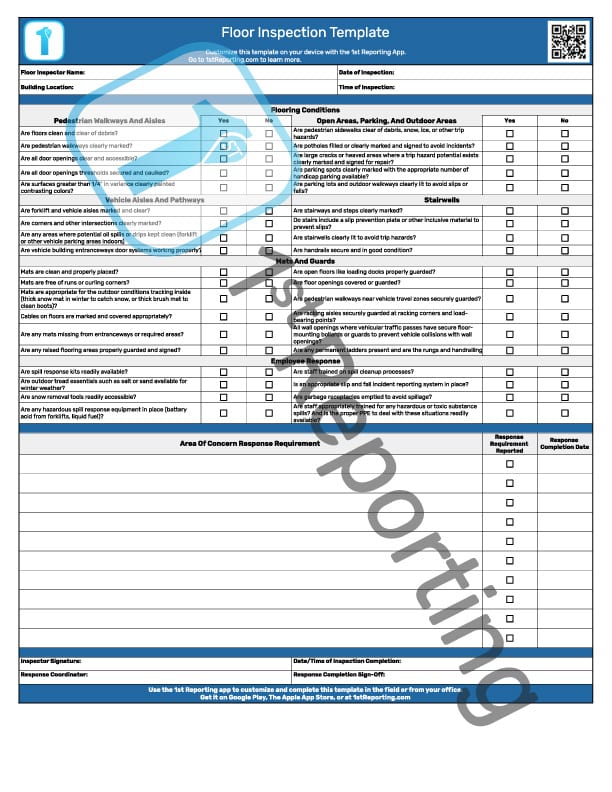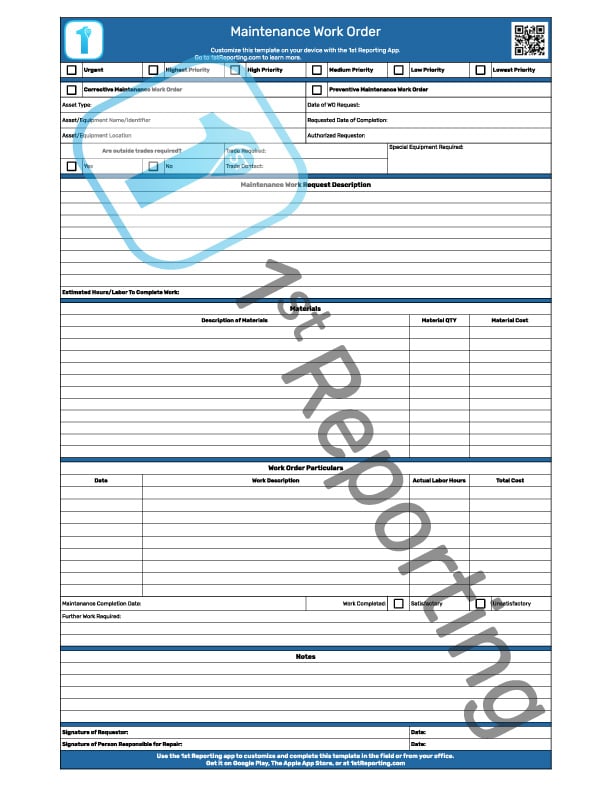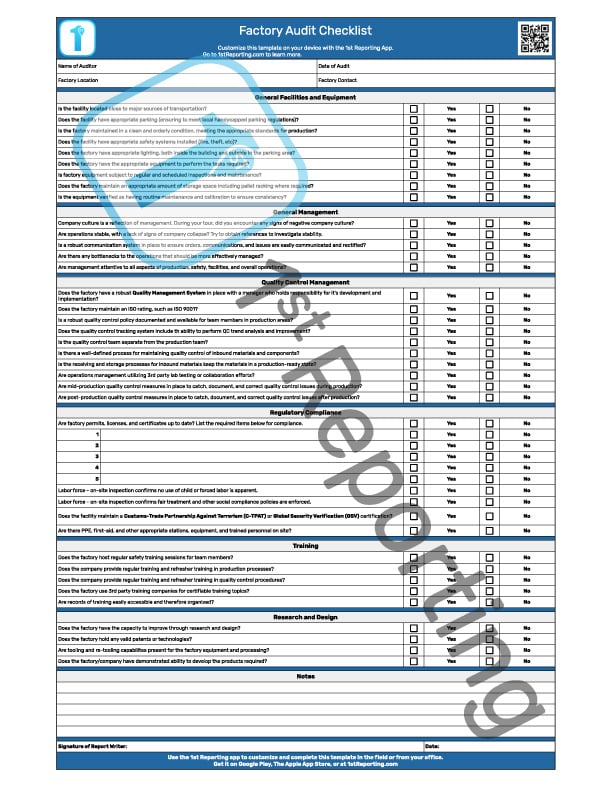
Operating any business with staff, clients, or both walking in or around your facility can raise certain liabilities regarding your floors and their condition. Implementing a regularly scheduled floor inspection with your staff is a great way to start mitigating those liability-producing risks.
Using a proper floor inspection template or checklist is essential to regular safety inspections, lowering your business exposure risk. The floor inspection reports allow your business to monitor, recommend repair, and track the responses to reported issues pertaining to floor safety in your workplace.
This article will provide you with a floor inspection template and provide some insights for its best use. Let’s jump in.
Included In The Floor Inspection Template
In the Floor Inspection Template, you will notice there are three primary components:
- Administrative Area
- Floor Conditions Checklist Area
- Area Of Concern Response Requirement Area
You can likely discern for yourself based on the clear titling of each subsection, but for clarity reasons, we’ll do a brief description of each so we’re on the same page.
Administrative Area
The Floor Inspection Template includes two sections for the administrative area. The first section, located at the top of the document, provides a place to note the inspector’s name, date, location of the facility, and the time the inspection occurred.
The second component to the administrative area of the template resides at the bottom of the document. This area allows for a final inspection completion signature and date by the inspector. The area also includes a response coordinator signature or name area and a response completion sign-off area to confirm completed response requirements.
Floor Conditions Checklist Area
The floor conditions checklist area is the meat and potatoes of the Floor Inspection Template. The area is further broken down into six zones of inspection concern:
- Pedestrian Walkways And Aisles
- Open Areas, Parking, And Outdoor Areas
- Vehicle Aisles And Pathways
- Stairwells
- Mats And Guards
- Employee Response
Pedestrian Walkways And Aisles
The initial recommended inspection area for a workplace floor inspection is the pedestrian walkways and aisles. Tracing all employees, clients, and other pedestrian walkways throughout the workplace facility is an intelligent way to begin your flooring inspection.
Open Areas, Parking, And Outdoor Areas
This area is concerned primarily with outdoor and open areas. It provides several common checkpoints for areas not enclosed by racking, walls, or other constraints.
With walkways that build ice being a primary source of slips and falls, these sorts of hazards can even produce a fatality and should not be taken for granted. (source)
Vehicle Aisles And Pathways
One of the most significant sources of damage to facilities is vehicular traffic. Flooring is no exception here. This section is concerned with the aisles, pathways, and other areas where vehicular traffic is present and operating at your workplace.
Vehicles like forklifts produce a great deal of risk for pedestrians in the workplace. According to the U.S. Bureau of Labor Statistics, from 2011 to 2017, 614 fatalities occurred due to workers being killed by forklifts. It is another reason never to overlook the floors in areas where vehicular traffic is present. (source)
Stairwells
Often overlooked during flooring safety inspections, stairwells are a severe source of risk due to climbing up and down levels and the potential for tripping and falling hazards. This section of the floor inspection template provides the inspector with common safety questions to ensure that stairwells are safely maintained.
Mats And Guards
Mats at workplace entrances are an essential part of the safe floor processes of workplaces. They allow incoming traffic to deposit any soil, snow, or other things sticking to the footwear. The process is vital to maintaining clean and slip-free workplace walkways.
Similar to the safety concepts of the floor mats, guards and railings are also equally vital to a safe workplace. Guards can prevent vehicles like forklifts from striking racking and other equipment.
Employee Response
As you are well aware, we can talk about and report issues with flooring until we are blue in the face. However, if no one does anything to respond to floor hazards, then the hazards will compound until there is an incident to report.
How your staff responds to spills and other floor-related concerns will determine how competent your business and, ultimately your ability to manage the risks are. The employee response section of the Floor Inspection Template provides a reasonable set of questions your floor inspection and floor safety auditor will determine. It includes things like hazardous liquid spill response training and other vital questions to promote a safe workplace.
Area Of Concern Response Requirement Area
The third primary area of the Floor Inspection Template provides the inspector with a place to note concerns that require remediation. There are a number of blank rows where the inspector might note damages or other concerns and a checkpoint to ensure these concerns are adequately communicated to the appropriate personnel.
When it comes to communicating inspection results for remediation, a printable checklist like the one we are providing you for free is an intelligent tool for your floor inspection toolkit. However, a digital solution is an even better idea.
Take a moment to consider automating your reporting process using a solution like 1st Incident Reporting’s mobile reporting application. With customizable templates and notifications, you can have the right people notified in real-time the moment your inspector hits the save button on their phone, tablet, laptop, or another device. Automating the report-sharing process via a cloud-based application ensures that the right people can access the report at the right time from anywhere with an internet connection, including Android or iOS devices.
How To Use The Floor Inspection Template
Using a downloadable floor inspection template is excellent, and we’re glad you’ve decided to take action using our provided solution! You’ve made the right step towards preventing injury in the workplace and lowering business hazard risk.
For best practice, we recommend downloading the template and copying the sheet, which is pre-formatted to suit a standard eight by eleven sheet of paper. Distribute the floor safety audit to your staff and set up a scheduled inspection program.
For best results, inspectors should inspect the workplace floors at the beginning of each day or shift. If you are running a 24-hour operation, we recommend inspection at least once every 24 hours. A high frequency of inspections such as this will yield the highest possible results for capturing hazards pre-incident.
For your chosen inspectors, we also recommend a rotating inspection schedule. Often, when a single person is tasked with the responsibility of daily inspection, they have a chance of missing aspects of the inspection repeatedly if they are missed on the first pass.
Having a second or even third inspector realizes the potential for more incredible hazardous situation capture and hazard analysis. As they say, two heads are better than one, and in this case, four or more eyes are the best.
3 Tips For Your Floor Inspection Reporting Success
As mentioned above, we’ve already covered a couple of tips regarding the frequency of inspection and the number of inspectors. However, there are a few other things that you can do to improve the process even further.
- Complete A Semi-Annual Management Escorted Inspection
It’s a great idea to have your staff inspectors complete a regular floor inspection. However, how do you ensure that your inspectors are on point? Setting up semi-annual management escorted inspections is one way to ensure that your inspecting staff is performing their duties within the prescribed parameters.
- Setup A Hazard Mitigation Reporting Process
Utilizing staff skills to complete regular floor safety inspections is essential to your health and safety program. But what happens once a fault is found? To whom does the inspector report the inadequacy? And who does the follow-up?
You need to maintain both sides of the floor inspection coin. One side holds the inspection process, and the other side the repairs, upgrades, or mitigating actions to remove or reduce the hazard or risk.
Ensure that you have both sides of the process covered. It is the reason why we’ve included the mitigating action check-off and completion zones within the Floor Inspection Template.
- Use A Digital Reporting Solution
We mentioned earlier some of the core benefits of using a digital reporting solution for your floor inspections. However, there’s so much more functionality that could be of great use that we felt a revisit to the functional improvements you can make to your reporting process is worth another mention. Let’s take a deeper look at how a digital reporting solution can affect and transform your reporting and inspection processes for the better.
The Digital Floor Inspection Report
Using a digital reporting solution is the next evolution for your business reporting process. Sure, a downloadable Floor Inspection Template like the one we’ve provided is a great idea, but what if you didn’t have to print anything?
The 1st Reporting app delivers just the type of solution a business is looking for to satiate the needs of in-house reporting. The app works tirelessly on most devices, including Android and iOS devices. That means you can send your inspector with their staff smartphone or tablet to complete their inspection.
Here are a few of the key features that your business can further benefit from:
- Customizable templates to adjust your solutions to fit your particular business needs
- Customizable notification so you can automate who finds out about a completed report the moment it is done.
- Cloud-based solutions mean that anyone in your company, with permission, may access reports and even create further reports to detail the metrics of your reporting processes. You can track incidents, sort by type, and generate reports to identify critical factors that affect the operations of your business.
- A variety of pre-built templates allows you to start reporting the moment you’ve got the app set up on your device. Our template library covers many topics, from daily vehicle inspections to injury reporting processes to near-miss reports and, of course, incident reports. This library means that you’ve already got many of the templates, checklists, audits, and report templates ready to use at your disposal.
These are but a few of the features of the secure platform. Created with your security and reporting in mind, the 1st Reporting app aims to take your Floor Inspection process and other needs to the next level, increasing your efficiency and helping your business automate processes.Take it for a test drive today. Just jump over to our main page and sign up for your trial today.





